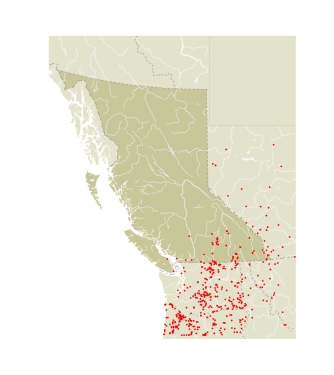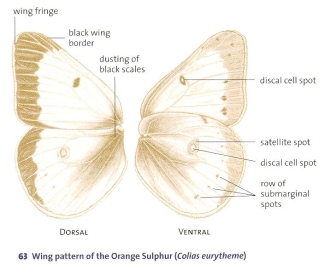View Desktop Page
Colias eurytheme Fabricius, 1807
Alfalfa Sulphur; Sulphurs
Family: Pieridae (Whites, Marbles, and Sulphurs)
The Families of Lepidoptera of BC
Alfalfa Sulphur; Sulphurs
Family: Pieridae (Whites, Marbles, and Sulphurs)
Species account authors: Crispin Guppy and Jon Shepard.
Extracted from Butterflies of British Columbia.
Introduction to the Butterflies of BCExtracted from Butterflies of British Columbia.
The Families of Lepidoptera of BC
Map click to expand contents

Distribution of Colias eurytheme in British Columbia.
(Click on the map to view a larger version.)
Source: Butterflies of British Columbia by Crispin Guppy and Jon Shepard © Royal BC Museum
Illustration click to expand contents
Click on the image(s) below to view an expanded illustration for this taxon.

Illustration Source: : Butterflies of British Columbia by Crispin Guppy and Jon Shepard © Royal BC Museum
Species Information click to expand contents
AdultOrange Sulphurs are very similar to Clouded Sulphurs, but are always predominantly orange on the upperside of males and most females. The black borders of the upperside tend to be broader than in Clouded Sulphurs, and the row of submarginal spots on the underside of the wings are more pronounced. The summer generation has completely orange wings with black borders, and the spring and fall broods have yellow wings with an orange patch restricted to the base of the wings. Most females are orange, or yellow and orange, with black borders. White female Orange Sulphurs have wider black borders, and the spots within the black border are larger, than those of white female Clouded Sulphurs (Hovanitz 1948).
Immature StagesEggs are initially white, translucent, and pointed at the upper end; they also have longitudinal ribs. They turn red after a day or two, then black before hatching. Mature larvae have a dark velvety green back, with each segment finely creased. On each side, there is a narrow white lateral line, through the middle of which is a line of vermilion red to orange yellow dashes. The underside is green, and the head is green and translucent. Pupae are light green with a lateral yellow line, above which is a brown point on each segment. A subdorsal brown patch commences at the edge of the wing covers and occupies two or three segments. Another colour form has a whitish lateral line along the abdomen, with a black stripe above the line for the first two or three abdominal segments. Compared with Clouded Sulphurs, the mature larvae of the Orange Sulphur are larger, their lateral spots are a brighter scarlet, and they lack semi-circular black spots under the lateral band. The pupae of Orange Sulphurs have a more attenuated head case, the mesonotal process is less prominent, and some abdominal markings are absent (Edwards 1868-72).
SubspeciesNone. The type locality has been restricted to Sacramento, CA (Emmel et al. 1998a).
Genus Description click to expand contents
|
Biology click to expand contents
|
Habitat click to expand contents
|
Distribution click to expand contents
|
Status Information click to expand contents
|
BC Ministry of Environment: BC Species and Ecosystems Explorer--the authoritative source for conservation information in British Columbia. |